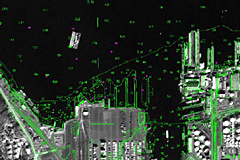
|
|
Since the late 1930s, high-resolution, georeferenced aerial photography for defining the nation’s 95,000-mile shoreline has been a responsibility of the National Geodetic Survey, part of NOAA’s National Ocean Service (NOS). Precision aerial photography is the primary source material used for creating coastal survey maps and digital cartographic files. These data sets, in turn, provide data for producing NOAA nautical charts. Determining the accurate location of the shoreline is extremely important because it defines the boundaries between private, state, and federal ownership and jurisdictions, including the territorial sea and the Exclusive Economic Zone. These photographs have many other uses as well, including coastal management, waterfront development, natural resource identification, measuring water depths, topographic mapping, mapping seabed characteristics, and locating features or obstructions to ensure the safety of marine and air navigation. The primary aerial photographic product is a 9x9-inch color photograph usually at scales from 1:10,000 to 1:50,000. More than 500,000 photo negatives, dating from 1945 to the present year, exist in NOS archives and are maintained by NOS’s National Geodetic Survey. Aerial photography surveys are conducted on varying time cycles, depending on the amount of change caused by human or natural forces. Other types of photographs include panchromatic, false-color infrared, and black-and-white infrared.
Related Projects and Technologies A major project involving aerial photography and shoreline mapping is the Topographic Change Mapping project. This project involves acquiring high-resolution topographic data through remote-sensing technologies for coastal resource managers. Topography is the general shape or form of land surface, including its relief and arrangement of features. NOAA Coastal Services Center (CSC) is significantly involved in this project. Both NGS and CSC are using new remote-sensing technologies to map coastal topography and the shoreline in the United States. These include Light Detection and Ranging (LIDAR), Interferometric Synthetic Aperture Radar (IfSAR or InSAR), and Airborne Visible and Infrared Imaging System (AVIRIS).
|
|
|||||||||||||||||||
|
|||||||||||||||||||||
|
Revised July 21, 2004 | Questions, Comments? Contact Us | Report Error On This Page | Disclaimer | User Survey |



